“Despite several disasters which occured after we are attending to, we never left the victims of Typhoon Yolanda. Recovery and rehabilitation efforts are in full swing in all the affected areas,” according to Department of Social Welfare and Development Secretary Corazon Juliano-Soliman.
Sec. Soliman made this assurance as the country commemorates the second year of Typhoon ‘Yolanda’ on November 8.
Meanwhile, government agencies tasked with the recovery and rehabilitation of ‘Yolanda’- affected areas held a joint press briefing this morning at the Development Academy of the Philippines (DAP), Ortigas, Pasig City.
The different clusters, namely:
Support led by the Department of Budget and Management (DBM), Infrastructure by the Department of Public Works and Highways (DPWH), Social Services by DSWD, Livelihood by Department of Trade and Industry (DTI), and Resettlement led by Housing and Urban Development Coordinating Council (HUDCC), and National Housing Authority (NHA) gave updates on accomplishments.
DSWD Assistant Secretary Vilma Cabrera who represented Secretary Corazon Juliano-Soliman reported that the agencies under the Social Services Cluster focused on health security through the delivery of priority medical program and projects; provision of Emergency Shelter Assistance (ESA) for 987,545 families (96%) out of the total target of 1,028,329 families with damaged homes; delivered books and learning materials and, strengthened and institutionalized partnership with the Local Government Units (LGUs), United Nations agencies, local and international non-government organizations, civil society organizations, and private donors in the implementation of major and support programs and projects for communities in resettlement sites.
The Cluster also implemented the repair and rehabilitation of damaged structures, and the construction of new ones using the Community–Driven Development (CDD) approach of the KapitBisig Laban sa Kahirapan Comprehensive and Integrated Delivery of Social Services (Kalahi-CIDSS).
Out of the funded 13,876 sub-projects, 2,887 have been completed to date which are mostly roads, flood/river control, community center and multi-purpose halls; footpaths, foot and access trails/ electrification and lighting, school buildings, water system, day care centers, health stations and bridges.
From tents to transitional shelters to permanent homes
Meanwhile, as of October 14, DSWD, in partnership with NGOs, such as Operations Blessing, Catholic Relief Services, Operations Compassion and Oxfam has completed construction of 2,315 transitional shelters in Leyte, Eastern Samar, and Western Samar.
A total of 1,576 families or 7,302 individuals are staying in these transitional shelters.
On the other hand, the National Housing Authority (NHA) which is tasked for the construction of permanent houses for Yolanda victims has completed 17, 641 units while 41,566 units are ongoing.
About 929 units were turned-over at Tanauan and Tacloban City, Leyte.
A total of 92,544 housing units are targeted to be completed until December 2016,
About 1,500 families who have already relocated to permanent housing sites in Ridgeview Park, Villa Sofia and Villa Diana will have their own source of potable water through a water supply support system.
Ten water tanks were installed in Ridgeview Park, two in Villa Sofia and three in Villa Diana. Each water tank will have a capacity of 5,000 liters.
The water supply support system, which includes on-site water source development, water filtration and rain harvesting, was made possible through the donation of the Nigerian Government amounting to US $300,000 (equivalent to P14-M). The project which costed P10M is a joint undertaking of the DSWD and the International Organization for Migration (IOM).
Asec. Cabrera said that rehabilitation and recovery efforts in affected areas are on track.
She added that survivors continue to demonstrate their resiliency two year after the disaster. ###


